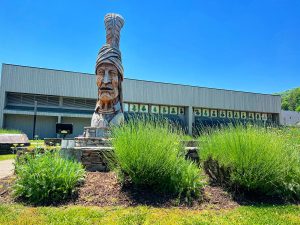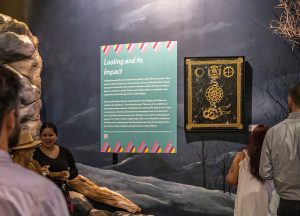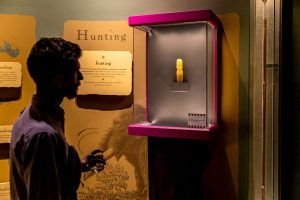

Shana Bushyhead Condill is a citizen of the Eastern Band of Cherokee Indians and has always considered Western North Carolina and the Smokies home. Because her father traveled to work in “Indian Country” across the US, she was born in Montana, then lived in Oklahoma and Wisconsin until she went to Illinois Wesleyan University.
“My parents took me to museums for as long as I can remember, and we have always enjoyed history in general,” she says. “For whatever reason, I never considered museum work until my English professor brought in a speaker named Danyelle Means (Oglala Lakota Nation) who was with the then-new National Museum of the American Indian (NMAI). I was stunned that there was a national museum for Native people—and I have been hooked ever since.”
Condill created her own multi-disciplinary course of study, interning at both NMAI and her own Tribal museum adjacent to Great Smoky Mountains National Park. She then applied to all the museum studies programs she could find—not many in that day—and ended up at the University of Delaware, where she earned her master’s in history and museum studies.
Today Condill is the executive director of the Museum of the Cherokee Indian (MCI) on the Qualla Boundary, the ancestral homelands of all three federally recognized Cherokee Tribes and the sovereign land of the Eastern Band of Cherokee Indians, owned by the Tribe and kept in trust by the federal government. Her career is focused on Native representation and self-representation in public spaces and combining mainstream museum best practices with Cherokee collections care. She is excited about a new exhibition called Disruption that exemplifies the protection of Native and Tribal culture by removing sacred objects from public view.

“Few people understand that these objects are incredibly important to us today,” Condill says. “Curiosity leads to extracting these objects from their communities—and actively looting burial sites still happens today.”
Condill hired Evan Mathis, the museum’s director of exhibitions and collections, in December of 2021. Together they conducted an inventory of the objects on exhibit in January of 2022 and quickly realized that they likely had funerary and ceremonial objects on view. Beau Carroll (Eastern Band of Cherokee Indians), lead archaeologist of the Tribal Historic Preservation Office, helped to identify objects that should be removed from the museum.
“We discussed the options for the empty cases—which could be a learning opportunity in itself—but Evan and Dakota Brown (Eastern Band of Cherokee Indians), our director of education, pitched asking Cherokee artists to respond. Thirty-six Eastern Band and Cherokee Nation artists answered the call—and the results are powerful.”
The work of these contemporary artists now disrupts the Museum’s chronological timeline. Among the contributions are ceramics, paintings, carvings, and sculpture, works on paper, multimedia, and site-specific works. Though the art was required to fit in selected display cases, guidelines were kept to a minimum, facilitating uniquely creative interpretations.

“Museum exhibitions can take years to develop, but our team came together quickly to make Disruption happen—and at such a high-level of quality,” said Condill. “We were able to install this exhibition in months.”
The focus on removal of objects can be traced to the Native American Graves Protection and Repatriation Act (NAGPRA) of 1990. In October of this year, the Department of the Interior opened a comment period on a proposal to “clarify and improve upon the systematic process for the disposition and repatriation of Native American human remains, funerary objects, sacred objects, or objects of cultural patrimony.” Comments can be made on the proposal through January 17, 2023.
“Most urgent, of course, was removing the objects from view,” Condill says. “But secondarily and also important is the opportunity to let our community know that we are caring for and protecting our culture. Ultimately, our goal is to bring every one of these objects home.”
Established in 1948, MCI is one of the country’s oldest and longest-operating Tribal museums. Located on the Qualla Boundary in Cherokee, North Carolina, close to Great Smoky Mountains National Park, its current permanent exhibition opened in 1998 and is toured by an estimated 83,000 visitors annually. MCI plans to update its permanent collection and build an offsite collections facility in the near future.

“The story of the Great Smoky Mountains will always be tied to the Cherokee,” Condill says. “The Eastern Band and the National Park Service are creating reciprocal partnerships that work for the benefit of this land, and we are always honored to assist in ensuring the historical and cultural lenses are added to those conversations.”
Condill points out that most exhibitions about Native people never involved Native people. But museums and institutions are beginning to realize that many lenses are relevant to effective storytelling.
“The challenge now is teaching institutions that have historically told stories and collected objects from a position of power how to respectfully partner with the communities they represent and correct harmful practices.”
On view through September of 2023, Disruption is an opportunity for museum visitors to learn about repatriation, NAGPRA, and Indigenous collections care. Learn more about the exhibit and how to support the museum at mci.org.
Subscribe to get the latest posts sent to your email.
The Great Smokies Welcome Center is located on U.S. 321 in Townsend, TN, 2 miles from the west entrance to Great Smoky Mountains National Park. Visitors can get information about things to see and do in and around the national park and shop from a wide selection of books, gifts, and other Smokies merchandise. Daily, weekly, and annual parking tags for the national park are also available.